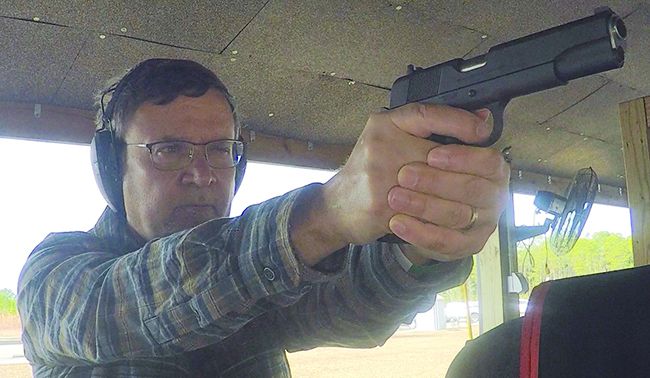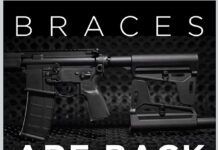When was the original M1911 adopted by the U.S. Military? As you might guess, the year was 1911, and the first model, the M1911, was used by General Black Jack Pershing’s expeditionary force of horse cavalry units to chase down Pancho Villa along the New Mexico and Mexico border in 1916. The M1911 was also used in WWI. Most modern 1911 pistol models take after the early M1911s, which had a flat mainspring housing and long trigger. Also, the iconic double-diamond checkered grips debuted on the M1911.
The U.S. Military made a few tweaks to the M1911 after the war that included a thicker front sight, long hammer spur, and arched mainspring housing, and a relief cut on the frame/receiver behind the trigger. These changes made this pistol more user friendly, and it was designated the M1911A1. Wood grips were replaced with checkered plastic grips, too. This model went on to be used in WWII and every other minor and major conflict or action until 1985, when the M1911A1 was dropped by U.S. ranks for the Beretta M9. The Marines and Army Special Forces still use 1911s, but they are modern models vastly different from the originals. All U.S. military 1911s are chambered in 45 Auto. The similarities with modern interpretations of 1911s end there.
GI and Mil-Spec–style 1911s are what many 1911 manufacturers call no-frills, plain-jane 1911 models. These models are stripped of any modern upgrades, such as accessory rails, snag-free or adjustable sights, magwells, extended beavertails, textured front grip straps, and a lot more. Typically, these models mimic some characteristics of the original 1911s Uncle Sam bought in the last century.
We requisitioned four GI/Mil-Spec style 1911s in 45 Auto to see how different they are from the originals and to see if these old combat pistols could still be used as defensive handguns. The four guns included the Taylor’s & Co. Full Size A1 1911, the Rock Island Armory GI Standard FS, the SDS Imports Tisas 1911 A1 U.S. Army 45 WG, and the Springfield Armory Defend Your Legacy Series 1911 Mil-Spec. The Rock Island, SDS, and Springfield pistols are closer to the amended M1911A1, while the Taylor’s is more like an original M1911. The Rock Island and Taylor’s were manufactured in the Philippines by Armscor, the SDS is made in Turkey by Tisas, and the Springfield Armory pistol is made in the U.S.
Generally speaking all four of these 1911s feature the classic dome shaped slide, tiny fixed sights, rear-only fine slide serrations, small beavertail safety spurs, plain grips, barrel bushing, lanyard loop, and spur hammers. All use a Series 70 internals which does not have a firing pin block and true to the original design. Since they all use a GI-stye bushing disassembly is easy and there is no need for extra tools. It’s the details that separate them from each other and originals and we will get into that later.
How We Tested
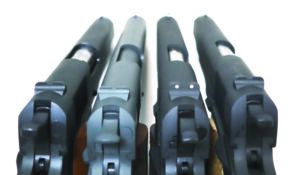
Accuracy testing took place at 25 yards away, and speed shooting was performed at 7 yards, where we ran the Mozambique Drill or Failure Drill — two rounds to center of mass and one round in the head of Thompson Targets B27 Stop targets, which present center-of-mass and head immobilization zones. Test ammo consisted of FMJ ball ammo and hollow points. Armscor 230 grains and Remington UMC 185 grains rounded out the FMJ ammo. We noticed the Remington ammo had the best accuracy across all the pistols. Defense ammo was 45 Auto +P Hornady Critical Duty 220-grain FlexLocks. We wouldn’t use +P ammo in an original 1911, but these modern clones are capable of handling the extra pressure. A steady diet of +P ammo will batter any pistol, and there was more recoil with the +P load, which manhandled the slide fast and hard. The Remington and Hornady loads produced noticeably more recoil than the Armscor ammo. The recoil was very tolerable, but the inside of some right-handed testers’ shooting-hand thumbs were rubbed raw on the bottom edge of the thumb safeties.
For concealed carry of these pistols, we used the Falco A105 Falcon IWB holster, belt, and ammo-pouch set from FalcoHolsters.com, $220, which allowed us to comfortably carry these heavy full-size 1911s. All three pieces of the rig wore a deep mahogany color. This leather is manufactured in Slovakia, and, like with all leather holsters, took some time to break in. We left one of the 1911s in the holster for a week, then repeatedly drew and re-holstered the gun to break in the leather. There was no retention device on this holster, just the friction of the leather against steel. We found the holster comfortable to wear, and it provided fast access to the 1911s. The belt is plenty sturdy to support the weight of these pistols, too. Both the holster and ammo pouch uses a sturdy metal clip that clamps onto the belt.
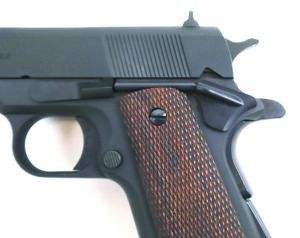
At the range, we averaged 2- to 2.2-inch five-shot groups at 25 yards across all four pistols, but as you can see in the range data, some pistols had moments when they absolutely shone, shooting tiny groups well under 2 inches. At 7 yards, these pistols were surgical. We did not experience any hammer bite, even though all the pistols had smaller grip-safety spurs compared to a modern beavertail. Also, we noticed that the Mil-Spec-style magazine releases do not extend from the frame as much as magazine buttons on more modern guns. To adjust, we had to change our shooting grip to completely press the button and drop the magazine. Also, we swapped magazines between all the pistols with no issues. The Springfield Armory and Tisas pistols used magazines truer to originals in design, while the Rock Island Armory and Taylor’s magazine designs were more modern and incorporated a bumper pad.
We had two failure-to-fire jams with Tisas and three with the Springfield, and none with the Rock Island Armory and Taylor’s. We re-oiled the Tisas and Springfield guns, which took care of the malfunctions. By the end of the test, all the guns were running extremely well. Here are the details of how they did.
Gun Tests Grade: A-
$623
It could be argued the Springfield Armory 1911 Mil-Spec is inspired by the M1911A1 because Springfield Armory adds a few choice modern 1911 features, such as a lowered and flared ejection port, match-grade stainless steel barrel, stainless-steel barrel bushing, larger thumb safety, and large three-dot sights. The Parkerized slide and frame finish is a smooth matte black, and the wood composite grips wear a nice checkering. This was the most expensive of the GI-style 1911s tested here, and we could tell by the well-done finish. It came in a soft-nylon zippered case. For the price, we think Springfield Armory could have thrown in a second magazine.
| Action | Semi-auto, locked breech single action |
| Overall Length | 8.6 in. |
| Overall Height | 5.5 in. |
| Maximum Width | 1.2 in. |
| Weight Unloaded | 39.0 oz. |
| Weight Loaded | 44.7 oz. |
| Barrel | 5.0 in. |
| Capacity | 7+1 (single stack) |
| Slide | Parkerized steel |
| Slide Retraction Effort | 19.0 lbs. |
| Frame | Parkerized steel |
| Frame Front Strap Height | 2.6 in. |
| Frame Back Strap Height | 3.2 in. |
| Grips | Wood composite, checkered |
| Grip Thickness (Maximum) | 1.3 in. |
| Grip Circumference (Maximum) | 5.2 in. |
| Sights | Fixed; white dot front/two-dot rear |
| Trigger Pull Weight | 4.3 lbs. |
| Trigger Span | 2.6 in. |
| Magazines | (1) steel |
| Safety | Thumb safety, beavertail grip |
| Warranty | Lifetime |
| Website | Springfield-Armory.com |
| Made In | U.S. |
The large white three-dot sights are much easier to use than the traditional small GI-style sights. This makes the Springfield Armory feel more modern. The slide serrations are angled, which is another small detail that veers away from the original vertical serrations. The left slide markings are a subtle “MIL-SPEC” on the left side and the Springfield Armory name and logo on the right side. The modern ejection port work optimizes ejection.
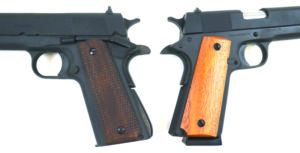
While the thumb safety is larger than an original, it is still a fraction of the size of an extended thumb safety. The hammer spur is narrow like on an M1911 and is serrated, as is the trigger face and magazine-release button. The arched mainspring housing is a nod to the M1911A1. It is also serrated.
The one blued-steel magazine that comes with the Springfield Armory Legacy pistol holds seven rounds and follows the design of original magazines. This magazine was slightly more difficult to load compared to the magazines in the Rock Island Armory and Taylor’s guns.
Running the Springfield Armory in the Failure Drill, we found the larger sights made aiming much easier. We were fast with the two center-of-mass shots and more surgical with the one head shot. The Springfield Armory cycled smoothly in hand, and it was easy to control. In accuracy testing, the best group was shot with Remington UMC 180-grain FMJs and measured 1.24 inches. With the Hornady Critical Duty defense ammo, the smallest group measured 2.06 inches. On average, across all ammos, the Springfield Armory shot an honest 2 inches. We had a few FTF jams initially, but a drop of oil fixed that, and afterward, the Springfield Armory ran well. Recoil was pronounced with the Hornady ammo, while recoil with the 230-grain FMJ Armscor ammo was mild.
The trigger-pull weight measured a nice 4.3 pounds. All the other magazines worked in the Springfield Armory with no issues.
Our Team Said: The Springfield Armory Mil-Spec had the best finish and the most modern features. While it is not a true Mil-Spec copy, we liked this pistol best for everyday carry due to the larger sights and better trigger.
45 ACP Range Data
To collect accuracy data, we fired five-shot groups from a bench using a rest. Distance: 25 yards with open sights. We recorded velocities using a ProChrono digital chronograph set 15 feet from the muzzle.| Hornady Critical Duty 220-grain FlexLock | Rock Island GI Standard FS | SDS Imports (Tisas) 1911 A1 US Army | Springfield Armory 1911 Mil-Spec | Taylor’s & Co. Full Size A1 1911 |
| Average Velocity | 1004 fps | 1015 fps | 1020 fps | 1028 fps |
| Muzzle Energy | 492 ft.-lbs. | 503 ft.-lbs. | 508 ft.-lbs. | 516 ft.-lbs. |
| Smallest Group | 2.15 in. | 2.02 in. | 2.06 in. | 1.52 in. |
| Average Group | 2.20 in. | 2.33 in. | 2.16 in. | 2.07 in. |
| Armscor 230-grain FMJ | Rock Island GI Standard FS | SDS Imports (Tisas) 1911 A1 US Army | Springfield Armory 1911 Mil-Spec | Taylor’s & Co. Full Size A1 1911 |
| Average Velocity | 881 fps | 880 fps | 889 fps | 887 fps |
| Muzzle Energy | 396 ft.-lbs. | 396 ft.-lbs. | 404 ft.-lbs. | 402 ft.-lbs. |
| Smallest Group | 2.65 in. | 1.60 in. | 2.25 in. | 1.35 in. |
| Average Group | 2.77 in. | 1.68 in. | 2.28 in. | 1.80 in. |
| Remington UMC 180-grain FMJ | Rock Island GI Standard FS | SDS Imports (Tisas) 1911 A1 US Army | Springfield Armory 1911 Mil-Spec | Taylor’s & Co. Full Size A1 1911 |
| Average Velocity | 1017 fps | 1039 fps | 1027 fps | 1038 fps |
| Muzzle Energy | 413 ft.-lbs. | 432 ft.-lbs. | 422 ft.-lbs. | 431 ft.-lbs. |
| Smallest Group | 1.79 in. | 0.98 in. | 1.24 in. | 1.80 in. |
| Average Group | 1.85 in. | 1.12 in. | 1.53 in. | 1.96 in. |

























